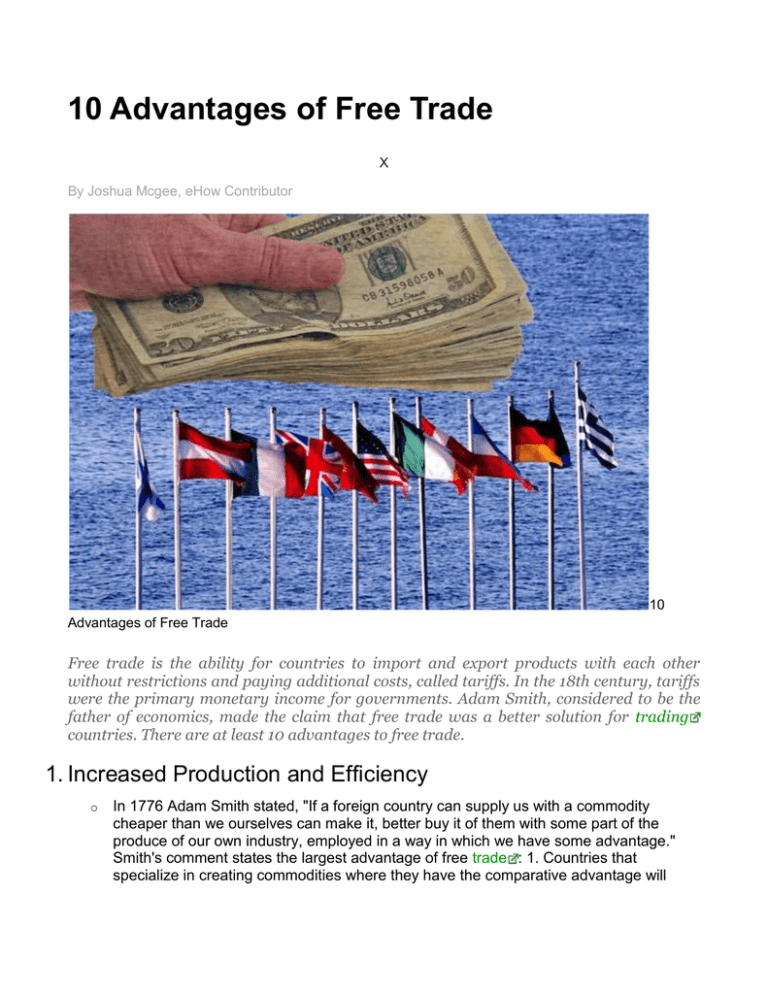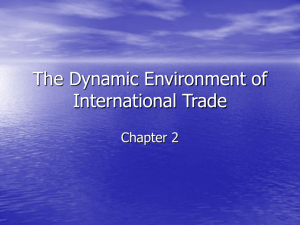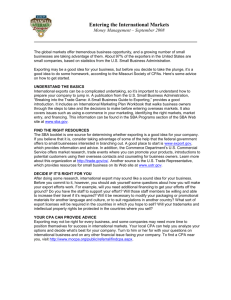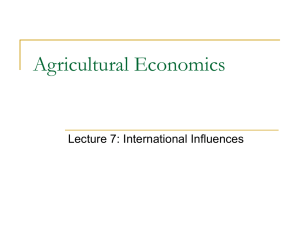Unit 410 Pros of free trade article
advertisement

10 Advantages of Free Trade X By Joshua Mcgee, eHow Contributor 10 Advantages of Free Trade Free trade is the ability for countries to import and export products with each other without restrictions and paying additional costs, called tariffs. In the 18th century, tariffs were the primary monetary income for governments. Adam Smith, considered to be the father of economics, made the claim that free trade was a better solution for trading countries. There are at least 10 advantages to free trade. 1. Increased Production and Efficiency o In 1776 Adam Smith stated, "If a foreign country can supply us with a commodity cheaper than we ourselves can make it, better buy it of them with some part of the produce of our own industry, employed in a way in which we have some advantage." Smith's comment states the largest advantage of free trade : 1. Countries that specialize in creating commodities where they have the comparative advantage will increase their production, instead of focusing on products or industries in which other countries have the comparative advantage. 2. By increasing production, countries increase their efficiency. By specializing, countries better allocate their resources and purchase cheaper resources from other countries. 2. Consumer Satisfaction o 3. Because free trade leads to a global market, consumers benefit from the competition and variety brought to the market. When other countries produce some items cheaper, the consumer purchases products for less. 4. Another benefit to consumers is increased innovations. As free trade expands, competition also expands. To stay competitive, companies must seek ways to create the comparative advantage. This leads to increased innovation that improves products. 3. Employment and Economic Growth o 5. Although free trade may cause jobs in one particular industry to wind up overseas, jobs in the exporting and importing sides will increase. When productivity increases in importing and exporting, wages also tend to rise. 6. As the U.S. has lowered its trade restrictions, the gross domestic product has risen. Since consumers can purchase quality products for cheaper, they have more expendable income. 4. Foreign Exchange Gains and Decreased Poverty o 7. When a country purchases a product from another country with money, they essentially send the exporting country non-interest IOUs in exchange for real goods. The exporting country, though, must use the money within the country that imported the products. For example, the United States purchases steel from China with U.S. money at the current market value. China will later use the U.S. money to purchase computer programs from the United States at the future market value. 8. Countries that open their trade barriers to allow free trade have the chance to enter the global market, which will increase income for the country. In the 1990s, developing countries that lifted trade restrictions tended to grow three times faster than countries that restricted trade. 5. Increased Export o 9. Countries with stringent trade restrictions often cause animosity with other countries. Therefore, the country with the restrictions also limits its own ability to export. When a country removes their trade restrictions, other countries are more willing to accept the exports. Minimizes War o 10. As countries work together professionally, mutual respect for the countries' customs and cultures increase. Fears and prejudices diminish, and countries are less likely to fight each other.









